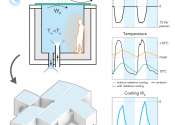In Iceland, CO2 sucked from the air is turned to rock
At the foot of an Icelandic volcano, a newly-opened plant is sucking carbon dioxide from the air and turning it to rock, locking away the main culprit behind global warming.
Nov 2, 2021
4
283
Energy & Green Tech

At the foot of an Icelandic volcano, a newly-opened plant is sucking carbon dioxide from the air and turning it to rock, locking away the main culprit behind global warming.
Nov 2, 2021
4
283
Robotics

The development of stimuli-responsive polymers has brought about a wealth of material-related opportunities for next-generation small-scale, wirelessly controlled soft-bodied robots. For some time now, engineers have known ...
Jan 30, 2023
0
5258
Energy & Green Tech

The latest trend in cargo shipping has roots in a concept that's been around a while. Say, 7,000 years or so.
Engineering

As the planet gets hotter, the need for cool living environments is becoming more urgent. But air conditioning is a major contributor to global warming since units use potent greenhouse gases and lots of energy.
Sep 25, 2023
0
49
Engineering

New research suggests that around 0.5% of global carbon emissions could be captured during the normal crushing process of rocks commonly used in construction, by crushing them in CO2 gas.
Mar 13, 2023
1
104
Energy & Green Tech

Nations around the world risk wasting $640 billion by continuing to prop up the coal industry rather than investing in less expensive and environmentally friendlier wind and solar power initiatives.
Energy & Green Tech

A team of researchers at the University of Melbourne, working with a colleague from the University of Manchester, has developed a device that can use humidity from the air to make hydrogen gas. In their paper published in ...
Energy & Green Tech

Scientists have created an "artificial leaf" to fight climate change by inexpensively converting harmful carbon dioxide (CO2) into a useful alternative fuel.
Nov 4, 2019
1
1031
Energy & Green Tech

Californians were told Wednesday not to charge their electric vehicles during peak hours, just days after the state said it would stop selling gas-powered cars, as the aging electricity grid struggles with a fearsome heatwave.
Aug 31, 2022
1
929
Consumer & Gadgets

Current severe heatwaves that will likely increase in severity and frequency in the future are driving a rise in the use of air conditioners, threatening the environment with their high energy consumption and refrigerants ...
Aug 16, 2022
3
69
Global warming is the increase in the average temperature of the Earth's near-surface air and oceans since the mid-20th century and its projected continuation. Global surface temperature increased 0.74 ± 0.18 °C (1.33 ± 0.32 °F) during the last century. The Intergovernmental Panel on Climate Change (IPCC) concludes that increasing greenhouse gas concentrations resulting from human activity such as fossil fuel burning and deforestation are responsible for most of the observed temperature increase since the middle of the 20th century. The IPCC also concludes that variations in natural phenomena such as solar radiation and volcanoes produced most of the warming from pre-industrial times to 1950 and had a small cooling effect afterward. These basic conclusions have been endorsed by more than 45 scientific societies and academies of science, including all of the national academies of science of the major industrialized countries.
Climate model projections summarized in the latest IPCC report indicate that the global surface temperature will probably rise a further 1.1 to 6.4 °C (2.0 to 11.5 °F) during the twenty-first century. The uncertainty in this estimate arises from the use of models with differing sensitivity to greenhouse gas concentrations and the use of differing estimates of future greenhouse gas emissions. Some other uncertainties include how warming and related changes will vary from region to region around the globe. Most studies focus on the period up to the year 2100. However, warming is expected to continue beyond 2100 even if emissions stop, because of the large heat capacity of the oceans and the long lifetime of carbon dioxide in the atmosphere.
An increase in global temperature will cause sea levels to rise and will change the amount and pattern of precipitation, probably including expansion of subtropical deserts. The continuing retreat of glaciers, permafrost and sea ice is expected, with warming being strongest in the Arctic. Other likely effects include increases in the intensity of extreme weather events, species extinctions, and changes in agricultural yields.
Political and public debate continues regarding climate change, and what actions (if any) to take in response. The available options are mitigation to reduce further emissions; adaptation to reduce the damage caused by warming; and, more speculatively, geoengineering to reverse global warming. Most national governments have signed and ratified the Kyoto Protocol aimed at reducing greenhouse gas emissions. A small number of scientists dispute the consensus on global warming science.
This text uses material from Wikipedia, licensed under CC BY-SA